-
 Customisable
Customisable

Custom Vinyl Cloth Write-On Labels
£99.99Supplied in: Pack of 350 -

Calibration Due Aluminium Foil Dots
£79.99Supplied in: Pack of 1050 -

Calibration By Self-Laminating Write-On Labels
From £59.99 To £99.99Supplied in: Pack of 250 -

Calibration Quality Control Write On Surface Labels
£116.99Supplied in: Roll of 350 -

Colour-Coded Self-Laminating Calibration Labels
£119.99Supplied in: Pack of 350 labels -

Calibration Quality Control Write On Green/White Labels
£116.99Supplied in: Roll of 350 -

Calibrated Quality Control Write On Self-Adhesive Labels
£116.99Supplied in: Roll of 350 -

Monthly Calibration Due Dots
£86.29Supplied in: Pack of 1050 dots -

Calibration By/Next Due Quality Control Write On Labels
£116.99Supplied in: Roll of 350 -

Calibrated By/Date/Due Nylon Cloth Write-On Labels
From £39.99 To £129.99Supplied in: Pack of 350 -

Cal / ID / Date / Due / By - Small Calibration Labels
£100.99Supplied in: Pack of 250 -

Calibrated By Self-Laminating Write-On Labels
From £59.99 To £99.99Supplied in: Pack of 200 -

Cal By / Date / Due - Small Calibration Labels
£100.99Supplied in: Pack of 250 -
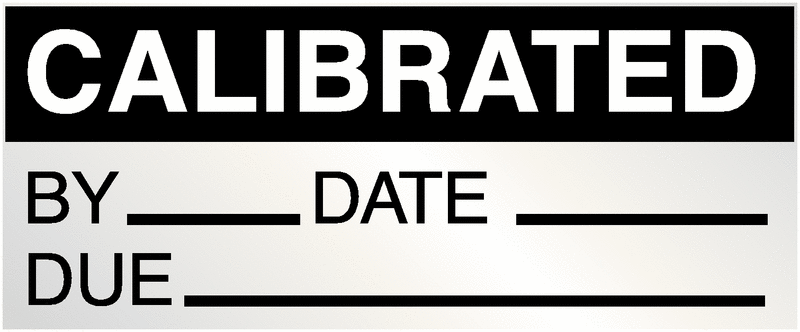
Calibrated By/Date/Due Foil Write-On Labels
From £41.99 To £108.69Supplied in: Pack of 350 -
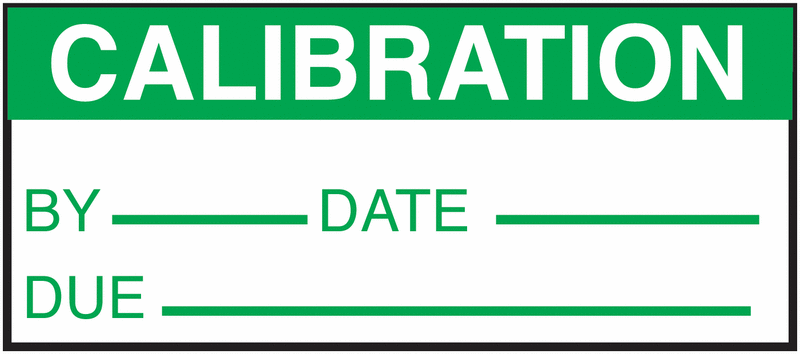
Calibration By/Date/Due Nylon Cloth Write-On Labels
From £39.99 To £129.99Supplied in: Pack of 350 -

Tested/Date/Initials Greasy/Oily Surface Label
£116.99Supplied in: Roll of 350 -
 Customisable
Customisable

Custom Vinyl Labels on a Roll
-

Calibration By/Date/Due Aluminium Foil Write-On Labels
From £41.99 To £108.69Supplied in: Pack of 350 -

Calibrated No./By/Date Tamper Resistant Labels
£90.59Supplied in: Pack of 275 labels -

Not Calibrated Indicator Only Foil Write-On Labels
From £41.99 To £108.69Supplied in: Pack of 100 -

Guarantee Void if Seal Broken Tamper Resistant Labels
£108.99Supplied in: Pack of 425 labels -

Restricted Calibration Nylon Cloth Write-On Labels
From £99.99 To £129.99Supplied in: Pack of 500 -
New

Calibration Record Inspection Tags
From £4.09 To £42.19Supplied in: Single -

3 Monthly Calibration Self-Laminating Write-On Labels
£59.99Supplied in: Pack of 100 -

Void If Broken Tamper-Resistant Calibration Labels
£108.99Supplied in: Pack of 225 -

Calibration By/Date/Due Jumbo Write-On Labels
£118.99Supplied in: Pack of 75 labels -

Calibration Not Required - Small Calibration Labels
£62.99Supplied in: Pack of 250 -

Do Not Use Until Tested Nylon Cloth Write-On Labels
From £39.99 To £129.99Supplied in: Pack of 100 -

Not Calibrated Nylon Cloth Write-On Labels
From £99.99 To £129.99Supplied in: Pack of 350 -

Re-Calibrated By/Date Nylon Cloth Write-On Labels
From £39.99 To £129.99Supplied in: Pack of 350 -

Serial No. - Aluminium Foil Write-On Labels
From £41.99 To £108.69Supplied in: Pack of 100 -

Pack of 500 - Calibrated Quality Control Write On Labels
£89.99Supplied in: Pack of 500 -

Calibrated By/Date/Due Jumbo Write-On Labels
£118.99Supplied in: Pack of 75 labels -
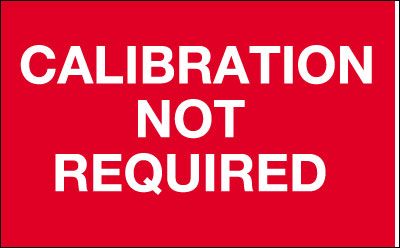
Roll of 250 - Calibration Not Required Inspection Labels
From £50.41 To £102.43Supplied in: Roll of 250 labels -

Calibration Quality Control Black/White Write On Labels
From £49.85 To £100.97Supplied in: Roll of 250 -
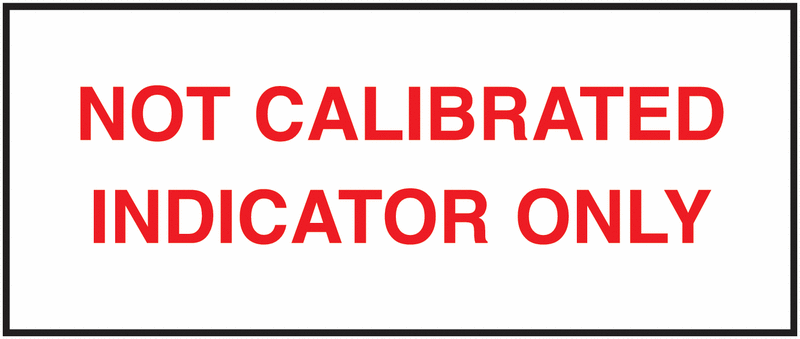
Not Calibrated/Indicator Nylon Cloth Write-On Labels
From £39.99 To £129.99Supplied in: Pack of 100 -

Roll of 250 - Calibration Due Quality Control Labels
From £44.99 To £109.32Supplied in: Roll of 250 -

Calibrate Before Use Nylon Cloth Write-On Labels
From £39.99 To £129.99Supplied in: Pack of 100 -

Not Calibrated - Aluminium Foil Write-On Labels
From £41.99 To £108.69Supplied in: Pack of 100 -

6 Monthly Calibration Self-Laminating Write-On Labels
From £84.99 To £99.99Supplied in: Pack of 200 -

Appliance Tested By Self-Laminating Write-On Labels
From £59.99 To £99.99Supplied in: Pack of 100 -
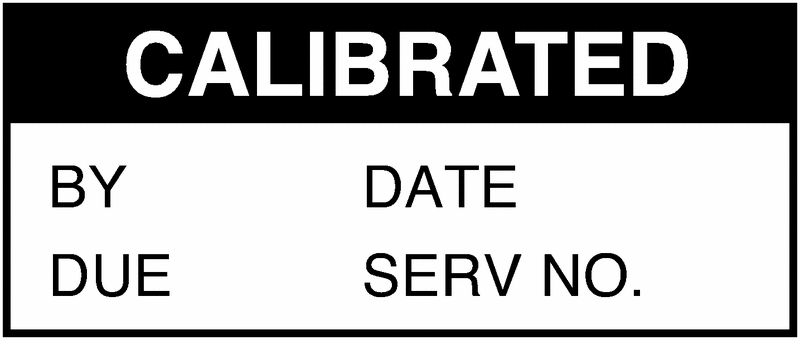
Calibrated By/Date/Serv No. Nylon Cloth Write-On Labels
From £39.99 To £129.99Supplied in: Pack of 100 -

Calibration Not Required Nylon Cloth Write-On Labels
From £39.99 To £129.99Supplied in: Pack of 100 -
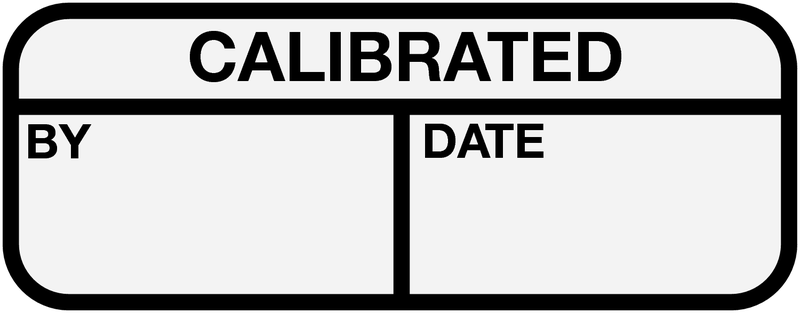
Calibrated By/Date Electrical Write-On Cable Markers
£129.69Supplied in: Pack of 350 -

Not Calibrated/Remarks/By/Date Material Control Tags
£30.99Supplied in: Pack of 10 tags -

Ok To Use Quality Control Write On Laminated Labels
£116.99Supplied in: Roll of 450 -

3-Monthly Calibration By/Date/Next Write-On Labels
£76.99Supplied in: Roll of 500 -

6-Monthly Calibration By/Date/Next Write-On Labels
£76.99Supplied in: Roll of 500 -

Calibrated By / Date / Next Test Due - Write-On Labels
£76.99Supplied in: Roll of 500 -

Instrument Checked By/Date/Next Due Write-On Labels
£76.99Supplied in: Roll of 500 -

Monthly Calibration By/Date Write-On Labels
£76.99Supplied in: Roll of 500 -

Out Of Calibration Do Not Use Small Calibration Labels
£62.99Supplied in: Pack of 250 -

Calibration By/Date/Due Tamper Resistant Labels
£187.69Supplied in: Pack of 275 labels -

Calibration Void If Seal Broken Tamper Resistant Labels
£164.69Supplied in: Pack of 425 labels -

Calibration Invalidation Tamper Resistant Labels
£88.59Supplied in: Pack of 275 labels
Calibration Labels
In the work place it is essential that machinery and equipment are regularly calibrated to ensure measurement readings are accurate when compared to national standards. If not calibrated, measurements can begin to deviate away from such standards and may generate significant error in readings. If significant errors are found then you are at risk of having to recall all relevant product lines since the last calibration test took place. By using our calibration labels here at Seton, you can efficiently keep track of when machinery is due to be calibrated, subsequently eliminating the chances of inaccurate machinery going unnoticed.

Expert Information
Calibration labels – what you need to know
Calibration labels help you keep your finger on the pulse of testing and measuring accuracies. These stickers keep your operations informed and up to date.
‘Do not use’ stickers or calibrated labels are an easy, quick and cost-effective way to monitor when the apparatus was regulated and when the next checks are due. Seton understands the importance of these tags, labels and signs; and stocks an extensive range for every work environment.
For example, if you utilise instruments in harsh settings, our self-laminating calibration stickers resist damage from oils, dust and other contaminants. After writing the necessary information in the provided spaces, just seal the product tag with the supplied laminate.
Our roll of write-on calibration labels are another hardy option. These labels stick like glue to any surface, including greasy areas. With the muscle to resist most chemicals, they are an ideal choice for warehouses, factories and heavy-duty facilities.
Take a look at the following table, to compare the different material options of our range. At a glance you can see which signs are supplied with space to write on custom details and where they can be deployed.
At Seton, we supply a full range of high performance security and identification labelling solutions. Our assortment of asset and apparatus information labels are supplied in a wide array of materials - such as vinyl or aluminium foil and nylon - as well as a variety of label pack sizes to suit business service operations of all sizes.
Need to provide warning of an upcoming inspection? Need to remind individuals when the next test is due? We have you covered. Take a look at our expansive range of inspection labels.
Why is calibration important?
Calibration sustains accuracy, standardisation and reliability to ensure efficient and effective operations and results. When electrical machinery isn’t set up correctly, measurements will be off and negatively influence the quality, safety and lifespan of your instruments.
Accuracy is a key metric that drives successful outcomes – from readings to producing goods and maintaining machinery. Different calibrations include factors such as dimension confirmation, electrical values, force determination, temperature readings and torque measurements. The deployment of uncalibrated apparatus can result in:
- Returns and rejected parts: Uncalibrated machines are not efficient. They waste manufacturing materials and impact quality, leaving little choice but to pass on some of the high price of manufacturing to your customers.
- Higher labour and production costs: It’s expensive to fix things or redo them as you incur double the time, manpower and operational expenses.
- Bad market reputation: Inaccurate parts damage a company’s good name and alienate customers.
This is why items as simple as ‘out of calibration’ tags help to keep a business on its toes. They clearly show which machinery cannot be put into service at any given time.
Likewise, a ‘calibration not required’ label gives employees the green light to operate certain machinery. You can also get custom calibration labels that you can tailor for your workplace and instruments.
Don’t forget, it is just as important to ensure cables and wiring are regularly checked for safety. It is no good carrying out bringing a piece of machinery into service, if the power cabling is not up to safe working standards. Our pack of 350 electrical write on cable markers are a great way to see at a glance when such cables were last checked; as well as the identification of the individual responsible.
Take a look at Seton’s pack of 350 vinyl cloth write-on calibration labels. With their self-adhesive backing, they can be removed and repositioned as needed. They can be supplied in your choice of 5 different colours that are easy to spot for your various machinery categories.
Another customisable favourite is our round calibration labels on a roll. When choosing these, you can customise the text. They also stick to curved or uneven surfaces, making them ideal for places where rigid signs won’t work.
Advanced calibration labels, such as our roll of 500 monthly calibration status labels, boost workplace safety by indicating which machines are good to go and which ones need to be adjusted before operation. You can also combine this product with other warning labels, or as our serial number labels to spotlight safety.
What does the law say?
Correct alignment and checking of accuracy forms part of the maintenance and upkeep of your apparatus, including any asset issued to employees. The HSE emphasises that this boosts the reliability and safety of machinery.
“An effective maintenance programme will make plant and equipment more reliable. Fewer breakdowns will mean less dangerous contact with machinery is required, as well as having the cost benefits of better productivity and efficiency.
Additional hazards can occur when machinery becomes unreliable and develops faults. Maintenance allows these faults to be diagnosed early to manage any risks.”
HSE.gov.uk
It also helps to prevent breakdowns and service interruptions that interfere with your productivity and bottom line. In terms of the Provision and Use of Work Equipment Regulations (PUWER) 1998, you must:
- Maintain supplied work materials in an efficient state.
- Keep maintenance logs up to date, which includes calibrations and a status label.
This exercise also forms part of your risk management processes, as the timely calibration of devices identifies and eliminates risks that can lead to damage and injuries. Calibrated labels serve as reminders to attend to systems regularly.
“Work equipment is any machinery, appliance, apparatus, tool or installation for use at work (whether exclusively or not). This includes equipment which employees provide for their own use at work.”
HSE.gov.uk
For example, by simply marking machinery with a ‘calibration void if seal broken’ label, you pinpoint tampering and warn people not to operate the asset in question. Our pack of tamper-resistant calibration labels meet all your industrial, warehouse, condition assurance and safety marking needs as they are smudge-free and stay debossed when marked.
Also, keep in mind that some apparatus doesn’t need to be regularly adjusted. In a big setup with lots of machines and instruments, workers may get confused as to what needs inspection or alignment and what doesn’t. By clearly marking these elements, you save time and effort.
For this purpose, you can deploy custom calibration stickers or go with our pre-printed ‘calibration not required’ labels. These tags come on a roll of 250, in either self-adhesive vinyl or repositionable vinyl cloth to suit your needs.
We even have a roll of 500 instrument service tags for your testing and measuring equipment. These labels stick to any clean, dry surface and are made from high-performance matt vinyl for improved durability.
FAQs
What’s the difference between calibration and verification?
It would be easy to compare these terms and deemed them to mean the same thing however, calibration is concerned with the measurement accuracy of appliances, whereas verification is the stamp of approval assuring you that instruments operate within set specifications.
So, ‘not calibrated’ stickers on machinery indicate that measurement parameters might be off, rather than to say the machinery or its accuracy has not been verified.
What are calibration requirements?
The ISO 9001 requirements are the standards that must be met to ensure that measuring and testing devices adhere to proper performance management. This is why ‘not calibrated’ tags are also important for your quality control and asset optimisation procedures.
“ISO 9001 sets out the criteria for a quality management system and is the only standard in the family that can be certified to (although this is not a requirement). It can be used by any organization, large or small, regardless of its field of activity. In fact, there are over one million companies and organizations in over 170 countries certified to ISO 9001.
This standard is based on a number of quality management principles including a strong customer focus, the motivation and implication of top management, the process approach and continual improvement. These principles are explained in more detail in ISO’s quality management principles. Using ISO 9001 helps ensure that customers get consistent, good-quality products and services, which in turn brings many business benefits.”
iso.org
Are calibration stickers required?
As PUWER prescribes the due maintenance of devices- both electrical and mechanical, it can be deduced that calibration labels are a necessity for your workplace. A pack of quality control write-on tags such as round calibration stickers or 'due to be calibrated' aluminium foil labels can have a huge impact on your products, services and overall workplace safety.
Are ‘warranty void’ stickers legal in the UK?
Take a look around your home or work and you are almost certain to find an appliance or device fitted with a sticker of this nature. For the assurance of both the manufacturer and consumer these labels are usually designed to be tamper resistant. From a legal perspective, there isn’t certainty on these stickers in the UK.
In most circumstances, whether a third party worked on a product or not; the manufacturer must attend to problems during the warranty period, or pay the price. However, it’s recommended that manufacturers add tamper-resistant guarantee void labels to cover themselves.
This 425 label pack includes self-adhesive backing which means they are easy to apply. Whilst at the same time they are made from destructible vinyl, which means they are difficult to remove; adding a level of security as well as warning users against tampering.
How do I calibrate equipment?
Develop a dedicated procedure and assign responsible people for the job. Some appliances may require external specialists. Seton’s jumbo calibration labels are ideal for these instances as they contain a space for the identification of the person doing the calibrations.
If there is a risk of apparatus being interfered with following a test, consider our tamper resistant write on tags.
Whether you need ‘not calibrated’ stickers, ‘instrument checked’ labels or straightforward calibration information reminders, our team of experts gathered everything under Seton’s virtual roof.
Avoid costly mistakes and injuries. Don’t let your staff pay the price for outdated calibrations. Take control of your operations and add the labels you need to your order today. Remember; we always add fuss-free delivery from our UK distribution centre, to every order.

